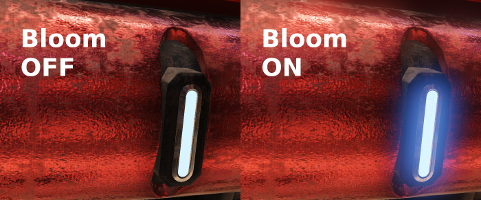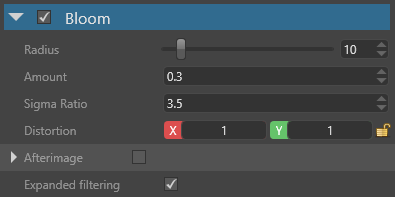Bloom
Intermediate Artist
The bloom effect takes the brightest areas of an image, extends them, and bleeds them into the surrounding areas to simulate bright light overwhelming the camera.

It uses the result of the bright filter effect as input.
Properties

| Property | Description |
|---|---|
| Radius | Radius of the bloom. Note that high values can affect performance. |
| Amount | Amount/strength of bloom. |
| Sigma Ratio | This affects the fall-off of the bloom. It's the standard deviation (sigma) used in the Gaussian blur formula when calculating the kernel of the bloom. |
| Distortion | Stretches the image horizontally or vertically. |
| Afterimage | Simulates afterimage (Wikipedia) — the effect of bright spots "burning" into the retina the longer you look at them, before fading away.
|
| Fade Out Speed | The factor by which the afterimage (if enabled) decreases at each frame (1 means infinite persistence, while 0 means no persistence at all) |
| Sensitivity | How sensitive the afterimage (if enabled) is to light. The higher this value is, the faster the effect is created when the camera focuses on a light. |
| Expanded filtering | Reverses FXAA and bloom, and uses a richer convolution kernel during blurring. This helps reduce temporal shimmering. |
See also
- Anti-aliasing
- Fog
- Outline
- Ambient occlusion
- Bright filter
- Color transforms
- Depth of field
- Lens flare
- Light streaks
